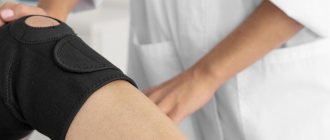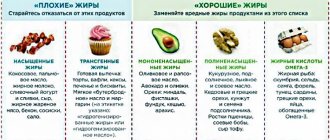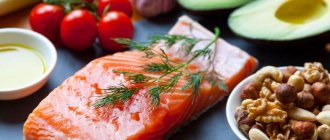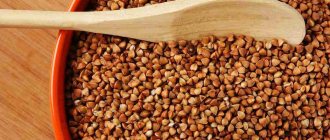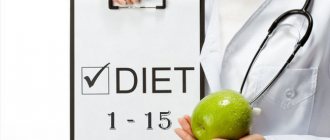The daily energy value is 3000-3400 kcal (proteins - 120 g, carbohydrates - 350-500 g, fats - 110 g).
- For breakfast - cottage cheese, oatmeal, tea.
For lunch - vegetable soups, fish, compote.
Recommendations for menu No. 12:
- The main principle is to exclude foods that excite the central nervous system.
It is recommended to exclude spicy foods, smoked foods, canned food, coffee and strong tea from your diet. To improve the functioning of the nervous system, foods containing B vitamins are prescribed. Daily energy value is 2300-2400 kcal (proteins - 80-90 g, carbohydrates - 350 g, fats - 70 g). - For breakfast it is better to choose buckwheat, fruit, juice.
- For lunch - soups with meat broth, steamed cutlets, vegetable stew.
- For dinner - vegetables, fish, compote.
Recommendations for menu No. 13:
- You can't go hungry. All foods must be boiled. Fried, spicy, fatty foods should be removed. Daily energy value - 2000-2100 kcal (proteins - 70 g, carbohydrates - 300 g, fats - 60-70 g).
- For breakfast - porridge, eggs, tea.
- For lunch - vegetable soups, steamed cutlets, juice.
- For dinner - meat, vegetables, compote.
Recommendations for menu No. 14:
- A nutritious diet includes foods that contain calcium (dairy products, fruits). Fatty, fried, spicy foods are removed. Daily energy value - 2600-2800 kcal (proteins - 90 g, carbohydrates - 350-400 g, fats - 100 g).
- For breakfast it is better to choose cereals, fruits, juice.
- For lunch - vegetable soups, fish, vegetable stew, tea.
- For dinner - meat, biscuits, jelly.
Recommendations for menu No. 15:
- This diet is prescribed when transitioning from all of the above diets. The range of products is varied, any heat treatment is allowed. Daily energy value - 2800-2900 kcal (proteins - 90-95 g, carbohydrates - 350-400 g, fats - 100 g).
- Porridge, eggs, tea are suitable for breakfast.
- For lunch - vegetable soups, fish, cereals, juice.
- For dinner - meat, porridge, vegetables, compote.
General rules
There is no doubt that good nutrition is the main component of a healthy lifestyle and human health in general.
Dietary nutritional therapy meets the physiological needs of the body and is adjusted depending on the course of the disease and the stage of the disease. Until 2003, the numbered diet system was based on a nosological principle (by disease), including 15 diets and numerous (up to 60) modifications. However, Table No. 1 , 5 , 7 , 9 and 15 . In 2003, a new nomenclature of diets was introduced, which for convenience combined the standard diets used in healthcare facilities and developed by M.I. Pevzner back in the 30s of the 20th century.
The new standard diet system includes:
- The main version of the standard diet (this is the decoding of the OVD) replaced the main therapeutic Tables according to Pevzner No. 1 , 2 , 3 , 5 , 6 , 7 , 9 , 10 , 13 , 14 , 15 , which do not require special restrictions on products. It is recommended for all healthy people to maintain health and for people suffering from gastrointestinal diseases in remission, acute febrile diseases and diseases of the cardiovascular system without circulatory disorders or with a minimal degree of disorders. In this regard, it is divided into: OVD1 (for diseases of the stomach with high acidity), OVD2 (diseases of the stomach with low acidity), OVD5 (diseases of the liver and biliary tract), OVD10 (cardiovascular system), etc. This diet is distinguished by its physiological content of proteins, fats, and carbohydrates. It is enriched with vitamins , minerals and plant fiber. The diet is 4-6 times a day, including snacks and fermented milk drinks at night. If you have diabetes, an adjustment is made: quickly absorbed carbohydrates are limited or eliminated, preference is given to foods with a low glycemic index. Patients should eat up to 5 times a day. This diet provides for the consumption of 85-90 g of protein (of which 40-45 g are animal), 70-80 g of fat (25-30 g of vegetable), 300-330 g of carbohydrates (simple - 30-40 g, which are excluded in case of sugar diabetes). The energy value of the therapeutic version of the diet is 2016-2400 kcal. When losing weight, reduce to 1500 kcal. The diet is limited to extractive substances (broths), salt (up to 8 g/day), spicy seasonings, smoked foods, as well as spinach and sorrel containing oxalic acid are excluded. Dishes are steamed, boiled or baked. The amount of liquid you drink is 1.5–2 liters per day.
- Option with mechanical and chemical sparing (includes Tables 1B , 4B , 4B , 5p ). Prescribed for gastrointestinal diseases. It is distinguished by the limitation of chemical (spicy, fried, extractive dishes) and mechanical irritants, so dishes are prepared exclusively by steaming or boiling; sometimes mashing or pureeing food is recommended.
- An option with a reduced protein content - a low protein diet (LPD) includes Tables 7A , 7B .
- With a high protein content - a high-protein diet (HPD), which includes Tables 4e , 4ag , 5p (second option), 7c , 37g , 9b , 10b .
- With reduced calorie content - a low-calorie diet (LCD) includes Tables 8 , 8A , 8o , 9A , 10C . Indicated for varying degrees of obesity without gastrointestinal complications. The diet provides for a moderate calorie restriction (1340-1550 kcal) due to fats (maximum 60 g in total) and the complete exclusion of easily digestible carbohydrates. It is enhanced by the content of plant fiber. Diet 5 times a day.
- With increased calorie content ( Table 11 ) for patients with tuberculosis - 3110-3640 kcal.
General characteristics of the OVD diet:
- It is balanced, so the feeling of hunger when doing it is eliminated.
- Designed for continuous adherence by healthy people and patients in remission.
- Contains healthy foods and a lot of fiber.
- Provides for fractional meals - 4 times or more when organizing snacks, which contributes to the rhythmic activity of the gastrointestinal tract.
- Involves preparing food by boiling, baking or steaming. These heat treatment methods do not involve the use of fats during cooking, so the food has a lower calorie content than fried food. In addition, it is easily absorbed and digested without disturbing the function of the digestive system.
- Excludes fatty and fried foods, extractive substances.
- Limits the consumption of simple carbohydrates and foods high in cholesterol.
The OVD diet, to summarize, is a healthy diet containing the physiological norm of all nutrients, aimed at maintaining a normal weight. If you want to lose weight, you will have to significantly increase physical activity and reduce caloric intake to 1500 kcal in your diet, or immediately choose an option with a reduced energy value, intended for obese patients .
Indications for use of the OVD diet
The OVD diet is used in the following cases:
- Chronic gastritis.
- Chronic stomach and intestinal ulcers.
- Chronic intestinal pathologies, accompanied by irritable bowel syndrome and constipation.
- Acute inflammation of the gallbladder.
- Acute hepatitis during the recovery stage.
- Chronic hepatitis (provided that the liver retains its functionality).
- Gout.
- Uric acid diathesis.
- Nephrolithiasis.
- Phosphaturia, hyperuricemia.
- Diabetes mellitus type 2 without obesity.
- Pathologies of the cardiovascular system, but without a pronounced disturbance in their functioning.
- IBS.
- Atherosclerotic lesions of the coronary arteries of the heart, brain and peripheral vessels.
- Infectious diseases in the acute stage.
- Fever.
Authorized Products
- Fish, steamed, boiled or baked.
- Lean meats and poultry prepared in the same way.
- Rye and wheat bread, flour products. These foods are limited when losing weight.
- Soups made from weak (secondary) broths or vegetable broths. To keep the diet varied, alternately include borscht, cabbage soup with fresh cabbage, rassolnik, various vegetable soups, beetroot soup (indicated for those prone to constipation ), and mushroom cereals. It is better to limit the consumption of the latter due to their higher calorie content.
- Any low-fat fermented milk drinks - yogurt, acidophilus, kefir, ayran, yogurt.
- Milk and sour cream for adding to dishes, cottage cheese 100-150 g per day, cheese 30 g.
- Boiled eggs or in the form of steamed, baked omelettes.
- Various cereals and pasta. They should be limited if you want to lose weight.
- Butter no more than 20 g, vegetable oils for seasoning dishes in the amount of 1-2 tbsp. l.
- Any vegetables according to tolerance. It's best to limit radishes, radishes, sorrel and spinach.
- Fresh fruits and berries in dishes (purees, mousses, jellies), compotes, juices, jelly and fruit drinks.
- Cocoa with water and milk, tea, coffee, rosehip infusion. According to the basic diet, sugar is allowed in the amount of 35 g per day. When losing weight, it is limited or eliminated.
Table of permitted products
| Proteins, g | Fats, g | Carbohydrates, g | Calories, kcal | |
Vegetables and greens | ||||
| zucchini | 0,6 | 0,3 | 4,6 | 24 |
| cabbage | 1,8 | 0,1 | 4,7 | 27 |
| cauliflower | 2,5 | 0,3 | 5,4 | 30 |
| carrot | 1,3 | 0,1 | 6,9 | 32 |
| cucumbers | 0,8 | 0,1 | 2,8 | 15 |
| beet | 1,5 | 0,1 | 8,8 | 40 |
| pumpkin | 1,3 | 0,3 | 7,7 | 28 |
Fruits | ||||
| apricots | 0,9 | 0,1 | 10,8 | 41 |
| oranges | 0,9 | 0,2 | 8,1 | 36 |
| watermelon | 0,6 | 0,1 | 5,8 | 25 |
| bananas | 1,5 | 0,2 | 21,8 | 95 |
| pears | 0,4 | 0,3 | 10,9 | 42 |
| melon | 0,6 | 0,3 | 7,4 | 33 |
| lime | 0,9 | 0,1 | 3,0 | 16 |
| lemons | 0,9 | 0,1 | 3,0 | 16 |
| tangerines | 0,8 | 0,2 | 7,5 | 33 |
| plums | 0,8 | 0,3 | 9,6 | 42 |
| apples | 0,4 | 0,4 | 9,8 | 47 |
Berries | ||||
| grape | 0,6 | 0,2 | 16,8 | 65 |
| strawberry | 0,8 | 0,4 | 7,5 | 41 |
| sea buckthorn | 1,2 | 5,4 | 5,7 | 82 |
| currant | 1,0 | 0,4 | 7,5 | 43 |
| rose hip | 1,6 | 0,0 | 14,0 | 51 |
Mushrooms | ||||
| mushrooms | 3,5 | 2,0 | 2,5 | 30 |
Nuts and dried fruits | ||||
| raisin | 2,9 | 0,6 | 66,0 | 264 |
| dates | 2,5 | 0,5 | 69,2 | 274 |
Cereals and porridges | ||||
| buckwheat (kernel) | 12,6 | 3,3 | 62,1 | 313 |
| cereals | 11,9 | 7,2 | 69,3 | 366 |
| corn grits | 8,3 | 1,2 | 75,0 | 337 |
| pearl barley | 9,3 | 1,1 | 73,7 | 320 |
| millet cereal | 11,5 | 3,3 | 69,3 | 348 |
| rice | 6,7 | 0,7 | 78,9 | 344 |
| barley grits | 10,4 | 1,3 | 66,3 | 324 |
Bakery products | ||||
| wheat bread | 8,1 | 1,0 | 48,8 | 242 |
| rye-wheat bread | 8,1 | 3,4 | 42,2 | 222 |
| Rye bread | 6,6 | 1,2 | 34,2 | 165 |
Raw materials and seasonings | ||||
| honey | 0,8 | 0,0 | 81,5 | 329 |
Dairy | ||||
| milk | 3,2 | 3,6 | 4,8 | 64 |
| kefir | 3,4 | 2,0 | 4,7 | 51 |
| sour cream | 2,8 | 20,0 | 3,2 | 206 |
| curdled milk | 2,9 | 2,5 | 4,1 | 53 |
| acidophilus | 2,8 | 3,2 | 3,8 | 57 |
| yogurt | 4,3 | 2,0 | 6,2 | 60 |
Cheeses and cottage cheese | ||||
| cheese | 24,1 | 29,5 | 0,3 | 363 |
| cottage cheese | 17,2 | 5,0 | 1,8 | 121 |
Meat products | ||||
| beef | 18,9 | 19,4 | 0,0 | 187 |
| veal | 19,7 | 1,2 | 0,0 | 90 |
| rabbit | 21,0 | 8,0 | 0,0 | 156 |
Bird | ||||
| chicken | 16,0 | 14,0 | 0,0 | 190 |
| turkey | 19,2 | 0,7 | 0,0 | 84 |
Eggs | ||||
| chicken eggs | 12,7 | 10,9 | 0,7 | 157 |
Oils and fats | ||||
| butter | 0,5 | 82,5 | 0,8 | 748 |
| corn oil | 0,0 | 99,9 | 0,0 | 899 |
| olive oil | 0,0 | 99,8 | 0,0 | 898 |
| sunflower oil | 0,0 | 99,9 | 0,0 | 899 |
Non-alcoholic drinks | ||||
| mineral water | 0,0 | 0,0 | 0,0 | — |
| lingonberry juice | 0,1 | 0,0 | 10,7 | 41 |
| green tea | 0,0 | 0,0 | 0,0 | — |
| black tea | 20,0 | 5,1 | 6,9 | 152 |
Juices and compotes | ||||
| compote | 0,5 | 0,0 | 19,5 | 81 |
| apricot juice | 0,9 | 0,1 | 9,0 | 38 |
| jelly | 0,2 | 0,0 | 16,7 | 68 |
| carrot juice | 1,1 | 0,1 | 6,4 | 28 |
| tomato juice | 1,1 | 0,2 | 3,8 | 21 |
| pumpkin juice | 0,0 | 0,0 | 9,0 | 38 |
| rose hip juice | 0,1 | 0,0 | 17,6 | 70 |
| * data is per 100 g of product | ||||
ABOUT
- OAA - burdened obstetric history
- OAA - Society of Alcoholics Anonymous
- CBC - Complete blood count
- OAM - general urinalysis
- PDA - Patent ductus arteriosus
- MBP - Myelin Basic Protein
- OBR - Over-the-counter
- OH - Orthostatic hypotension
- AGN - Acute glomerulonephritis
- OGP - Organs of the thoracic cavity
- OD - Right eye (from OD - oculus dexter)
- ARF - Acute respiratory failure
- ODS - Musculoskeletal system
- TLC - Total Lung Capacity
- TZHSS - Total iron-binding capacity of blood serum
- AUR - Acute urinary retention
- OIV - In Vitro Fertilization
- OI - Both eyes (from OU - oculi utriusque)
- AIE - Acute infective endocarditis
- AMI - Acute myocardial infarction
- OK - Oral contraceptives - Combined oral contraceptives
- OKN - Acute intestinal obstruction
- oxLDL - oxidized low-density lipoproteins
- OLD—Radiation Diagnostics Department
- ALL – Acute lymphocytic leukemia
- TPR - Total pulmonary resistance
- AML - Acute myeloid leukemia
- Compulsory medical insurance - Compulsory medical insurance
- ACVA - Acute cerebrovascular accident - Stroke
- OOiSBAHP - Other organs and systems without actual surgical pathology
- RLV - Residual lung volume - Spirometry
- OOO - Patent foramen ovale
- OPB - Regional Psychiatric Hospital
- OPG - General plethysmography
- surge arrester -
- TPR - Total peripheral resistance
- TPVR - Total peripheral vascular resistance - Arteriole
- OPT - General pathogenic therapy
- LTP - Long-term consequences of traumatic injury
- AIP - Acute intermittent porphyria
- ARVI - Acute respiratory viral infection
- ICU - Resuscitation and Intensive Care Unit
- ARI - Acute respiratory disease - Acute respiratory viral infection
- ARI - Acute respiratory infections
- ARF - Acute rheumatic fever
- ADEM - Acute disseminated encephalomyelitis
- OS - Left eye (from OS - oculus sinister)
- CCA - Common carotid artery
- OSMP - Emergency Department
- AHF - Acute heart failure
- OT - Optical tomography
- OTTG - Oral glucose tolerance test
- FEV - Forced expiratory volume - Spirometry
- FEV1 - Forced expiratory volume in 1 s.
- SPECT (SPECT) – Single photon emission computed tomography
- TC - Total cholesterol
- BCC - Circulating blood volume
- OCP - dyspnea-cyanotic attack
- TBI - Open traumatic brain injury
Fully or partially limited products
- Refractory fats, margarine, mayonnaise.
- Fatty meat broths.
- Fatty meat, poultry.
- Any fried food.
- Sausage, smoked meats, any canned food.
- Baking, sweets, jams, jams, sugar, ice cream, cakes and pastries are excluded when losing weight.
Table of prohibited products
| Proteins, g | Fats, g | Carbohydrates, g | Calories, kcal | |
Vegetables and greens | ||||
| canned vegetables | 1,5 | 0,2 | 5,5 | 30 |
| swede | 1,2 | 0,1 | 7,7 | 37 |
| canned cucumbers | 2,8 | 0,0 | 1,3 | 16 |
| radish | 1,2 | 0,1 | 3,4 | 19 |
| white radish | 1,4 | 0,0 | 4,1 | 21 |
| turnip | 1,5 | 0,1 | 6,2 | 30 |
| canned tomatoes | 1,1 | 0,1 | 3,5 | 20 |
| horseradish | 3,2 | 0,4 | 10,5 | 56 |
Confectionery | ||||
| cake | 3,8 | 22,6 | 47,0 | 397 |
Chocolate | ||||
| chocolate | 5,4 | 35,3 | 56,5 | 544 |
Raw materials and seasonings | ||||
| mustard | 5,7 | 6,4 | 22,0 | 162 |
| ketchup | 1,8 | 1,0 | 22,2 | 93 |
| mayonnaise | 2,4 | 67,0 | 3,9 | 627 |
| ground black pepper | 10,4 | 3,3 | 38,7 | 251 |
| sugar | 0,0 | 0,0 | 99,7 | 398 |
| vinegar | 0,0 | 0,0 | 5,0 | 20 |
Meat products | ||||
| pork | 16,0 | 21,6 | 0,0 | 259 |
Bird | ||||
| smoked chicken | 27,5 | 8,2 | 0,0 | 184 |
| duck | 16,5 | 61,2 | 0,0 | 346 |
| smoked duck | 19,0 | 28,4 | 0,0 | 337 |
| goose | 16,1 | 33,3 | 0,0 | 364 |
Fish and seafood | ||||
| smoked fish | 26,8 | 9,9 | 0,0 | 196 |
Oils and fats | ||||
| creamy margarine | 0,5 | 82,0 | 0,0 | 745 |
| animal fat | 0,0 | 99,7 | 0,0 | 897 |
| cooking fat | 0,0 | 99,7 | 0,0 | 897 |
| * data is per 100 g of product | ||||
E
- EAE - Experimental allergic encephalomyelitis
- EB - Electrolyte balance
- EGDS - Esophagogastroduodenoscopy
- EDTA - Ethylenediaminetetraacetate
- EIT - Electrical pulse therapy
- ECG - Electrocardiogram, Electrocardiography
- ECD - Epileptiform cognitive disintegration
- IVF - In Vitro Fertilization
- ECoG - Electrocorticogram
- ECS - Electrical pacemaker; Electrocardiostimulation
- EMG - Electromyogram, Electromyography
- ENMG - Electroneuromyogram
- EOG - Electrooculogram
- EOS - Electrical axis of the heart
- EP - Estrogen-progestin drugs
- EPKN - Emergency planned and advisory medical care
- ERCP - Endoscopic retrograde cholangiopancreatography
- ES - Endocrine system
- ES - Electrical stimulation
- SE - Status epilepticus
- ET - Essential tremor
- EPI - Electrophysiological study
- EchoCG - Echocardiography
- EchoCG - Echocardiogram
- EchoEG - Echoencephalogram
- EEG - Electroencephalography
- EEG - Electroencephalogram
Menu (power mode)
There are several options for OVD with strictly taken into account calorie content and prescribed BZHU content. After studying all the examples, you can choose the seven-day menu that is most suitable for you and suits your taste. You can create your own diet for the week without using foods from the prohibited list.
The seven-day menu below for the main options for standard diets has a calorie content of 1500 to 1700 kcal on different days of the week, excluding the consumption of bread, butter and sugar. If you add 150 g of rye bread, 150 g of wheat, 20 g of butter and 35 g of sugar (7 teaspoons in all dishes), the energy value will increase by 830 kcal, which is significant for a person who is trying to lose weight. This menu takes into account all the necessary nutrients, the food is very varied and is organized 6 times a day.
If eating this menu is not accompanied by weight loss, you can reduce the consumption of carbohydrates (porridge, potatoes) and replace them with vegetable dishes. This way you will reduce the energy value of your diet.
| Breakfast |
|
| Lunch |
|
| Dinner |
|
| Afternoon snack |
|
| Dinner |
|
| For the night |
|
| Breakfast |
|
| Lunch |
|
| Dinner |
|
| Afternoon snack |
|
| Dinner |
|
| For the night |
|
| Breakfast |
|
| Lunch |
|
| Dinner |
|
| Afternoon snack |
|
| Dinner |
|
| For the night |
|
| Breakfast |
|
| Lunch |
|
| Dinner |
|
| Afternoon snack |
|
| Dinner |
|
| For the night |
|
| Breakfast |
|
| Lunch |
|
| Dinner |
|
| Afternoon snack |
|
| Dinner |
|
| For the night |
|
| Breakfast |
|
| Lunch |
|
| Dinner |
|
| Afternoon snack |
|
| Dinner |
|
| For the night |
|
| Breakfast |
|
| Lunch |
|
| Dinner |
|
| Afternoon snack |
|
| Dinner |
|
| For the night |
|
Recipes for the table 3
Krupenik made from buckwheat and cottage cheese
On a 3-table diet, this dish is just what you need, since it combines healthy cottage cheese and buckwheat. In addition, this dish is very tasty and easy to prepare.
Necessary ingredients: buckwheat (1 cup), cottage cheese (200 grams), eggs (2 pcs.), sour cream (half a glass), milk (2 cups), salt (half a teaspoon), butter (2 teaspoons), sugar (2 teaspoons), breadcrumbs.
Preparation. In order to prepare a healthy krupenik for table 3, boil buckwheat in water. Next, wipe the cottage cheese with a blender or grind through a meat grinder. Mix buckwheat, cottage cheese, eggs, milk, sugar. Add salt. Mix the resulting adze well. Prepare a baking dish: grease it with butter and sprinkle with breadcrumbs. Place the dough in the mold, grease the entire resulting surface of the krupenik with sour cream and finally pour in a small amount of butter. Bake in the oven for 40 minutes.
To diversify your diet, use different types of cereals to prepare krupenik. For example, if you take oatmeal, you can add fruits and berries to such a dish.
Baked cabbage cutlets
Another healthy dish that contains both vegetables and cereals. Table No. 3 is perfect for a diet as a lunch or snack.
Required ingredients: white cabbage (400 grams), instant oatmeal (3 tablespoons), eggs (2 pieces), milk (half a glass), butter (2 tablespoons), salt to taste. You will also need silicone muffin cups.
Preparation. Finely chop the cabbage. Simmer it for 10 minutes in a frying pan, adding oil and water. Next, pour the oatmeal into the frying pan with the cabbage and pour in the milk. Stir the mixture. Continue simmering over low heat for another 10 minutes.
Remove the pan from the heat and let the cabbage cool slightly. Add 2 eggs to the mixture and salt it. Place the mixture into the molds. Bake the cutlets in the oven for 30-35 minutes. To follow the nutritional recommendations of Table 3, serve the cutlets with tomato or milk sauce.
Reviews and results
The main point of this diet is that it is balanced and contains the optimal calorie content for maintaining weight, and if it is reduced, for weight loss. Moreover, weight loss will occur slowly and without harm to health. This nutritional option is also suitable for overweight people with medical conditions. Strict adherence to all requirements will allow you to get rid of 500 g to 1 kg per week with increased physical activity. This rhythm of weight loss is the most optimal for losing weight.
- “... While staying in the sanatorium, I was on a similar diet. Only I didn’t eat pastries, sweets, I only took one piece of bread. At the same time, I ate porridge three times a day as a side dish for meat or fish. We were crushed by porridge - I don’t eat it three times a day at home, but there was no way out. There were also vegetable salads three times a day. I think that I ate normally and without any special restrictions. Imagine my surprise when, after 15 days, it turned out that the weight had decreased by 2 kg. I attribute this to the fact that the food was not fatty, and meat dishes were served boiled. All dishes were under-salted. I also went a lot (to the springs three times a day).”
- “... On such a diet I managed to lose 4 kg in a month. Yes, this is not much, but the important thing is that I did not feel hungry, I was cheerful and active. But to achieve such results, I ate porridge only once a day, sometimes twice, including milk. Potatoes were baked only 3 times in a month. For side dishes I used fresh or stewed vegetables, as well as various vegetable dishes. The diet was in the summer, so there was plenty of zucchini, eggplant, cucumbers, any greens, fruits (raspberries, currants, apricots). I made the juices myself. Of course, I excluded all unhealthy foods, and did not keep temptations in the form of sweets, cookies, and cakes in the house at this time. My conclusions: it’s easy to lose weight in the summer, eliminating fried foods helps, losing the first kilograms is easier - later I had to reconsider the diet and tighten it.”
Standards of diet therapy for cancer pathology
Among the main objectives of diet therapy for cancer, the leading place is occupied by the correction of metabolic disorders and adequate provision of the energy and plastic needs of the body.
In this regard, when prescribing therapeutic nutrition, it is necessary to determine the degree of disturbance of nutritional status using specific indicators based on the results of anthropometric, biochemical and immunological research methods. A comprehensive assessment of nutritional status using various criteria allows you to select adequate diet therapy that takes into account the identified disorders, as well as evaluate its effectiveness. The prescription of dietary therapy for various oncological diseases (ICD-10 codes C00-C96, D00-D48) is carried out in accordance with the “Nomenclature of Work and Services in Healthcare” (A25 - conservative methods of treatment).


